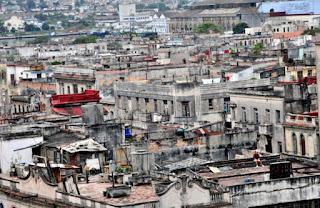 |
| Pepe Rivera |
 |
| El Caballero |
On the Calle de los Mercaderes Pepe Rivera, La Santiaguero, sits motionless outside a hostel for expectant mothers. He is not protesting. He’s making a living. He is a living statue though several passersby have mistaken him for the real thing, i.e. a statue. He is that good, so good, in fact, that he makes the statue of El Caballero de Paris look like it has a nervous tic. At Pepe’s feet is a satchel. Drop a coin into it, and Pepe comes to life—well, he comes to a snail’s pace life. He turns ever so slowly, lifts his eyes ever so slowly, and like a man traveling close to the speed of light, he extends his hand in a gesture of goodbye that feels as if it will take a lifetime to complete.
 |
| The buildings look as if they had a skin disease. |
Pepe is supplanting Fidel as my avatar for Cuba. He is a reminder that Havana is a surrealistic city.
 |
| Scaffolded Walls |
It is after all strange to pass block after block of abandoned buildings several stories high and to see boarded-up windows on the ground floor while clotheslines dangle outside broken floor-to-ceiling windows on the second floor. It has the feel of a Ridley Scott movie. I’m thinking, of course, of Blade Runner. There are electric wires that droop openly (and probably illegally) from one window ledge to the next as they snake their way along the facades of these boarded-up hulks. They are like dark rivulets of wire that shadowy inhabitants dip into the way a villager living alongside a forest stream might dip a bucket for water. Buildings are either collapsing or about to collapse. They look as if they have a skin disease. Then there are walls—single walls, in fact—held up by scaffolding the way you might support a drunk. All around the wall and its scaffolding is a vacant lot filled with the rubble of some previous collapse that has left nothing standing but the wall. Why haven’t the authorities put it out of its misery instead of forcing it to stand there in all in feebleness? If it were a horse, you would shoot it. And then there are the empty buildings with corrugated fences surrounding them and a gap, a guard at the gap, and painted in big black letters above the gap, “This is not a toilet.” Is it meant to impart a warning? Or information? Or is it an appeal (this is not a toilet, for Chrissake)?
Driving through the town at night is like driving through a blackout. There are hardly any lights and those that are there glow dimly and in the oddest of places: a tall office building, pitch dark save for a glimmer two floors from the top on the corner, or a squatter’s second floor room, a spare yellow gleam buried deep inside the building like a gravedigger’s lantern, the electricity most likely tapped from a nearby building.
Amid all of this descending rubble there are pockets of life—the Buena Vista Social Club, the San Cristóbal Paladar, and all the hot spots that lie hidden from the tourist trade because they are too authentic to share. And then there are all those 1950s chick mobiles floating through the city like particles from a different universe.
Havana is a contradiction. America is its enemy and yet it loves its enemy. What could be more surrealistic than a city in love with tail fins and grinning grilles? Havana is, indeed, a special place. Havana is a not a city that time has forgotten. It is a city that time is trying to remember.









{ 0 comments... read them below or add one }
Post a Comment